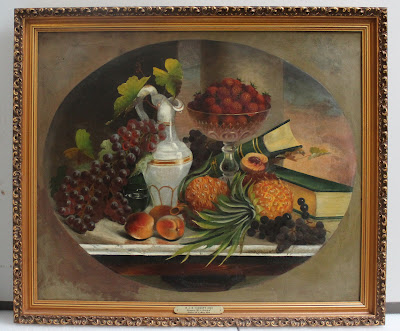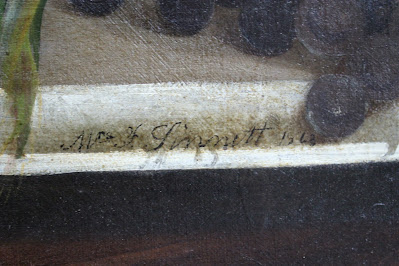by Monica Groth, Curator
Too often the work of women is overlooked or dismissed. In some cases, a woman's accomplishments are even erroneously attributed to a man.
I came across an example of the latter case recently. Coincidence brought about its discovery and the correcting of a decades old mistake. County Historian Kelsey Jones was researching the lives of two county artists - a couple, John Townsend and Frances Smith Sinnett - when I ran into him at the office. John Townsend Sinnett (1807-1891) was born in Dublin, Ireland and immigrated to the U.S., making painting his profession. His wife Frances, was born closer by, in Tioga County, and she too developed skills as an artist. We know that the couple lived at Southport Corners in the town of Southport by 1850, and had eight children by 1865.
Kelsey showed me a painting attributed to John Townsend Sinnett held by the Arnot Art Museum. This painting, included below with permission of the Arnot, is entitled Demon Rum Versus Water. It depicts the moral hazard of the alcoholic carafe, encircled by a serpent, by contrasting it with the purity of water, complemented by a white pitcher and a waterfall to the far right. I was impressed by the quality of the painting and the obvious skill of the artist, but was unfamiliar with their name. According to our database, there were no Sinnett paintings in our collection.
.jpg) |
| Demon Rum Versus Water, c. 1860 Image courtesy of the Arnot Art Museum |
However, only the next day, I was researching 19th century art to include in an upcoming exhibit and was struck by this painting, a colorful tableau filled with exotic fruits:
 |
| Still Life painted by Mrs. Frances S. Sinnett, 1863 |
Notice anything? The pitcher looked nearly identical to the one in Demon Rum Versus Water! The painting style is also similar - could the paintings be by the same artist? Or artists in the same household and studio using the same still life props?
Our painting, an untitled still life, was anonymously donated to the Museum in memory of Robert L and Mary Cain many decades ago. It is attributed to W.J.R. Sinnott, an artist seemingly unconnected to Frances or John. So who was W.J.R. Sinnott? History draws a blank. No one by that name appears to have lived in the area during the 1860s. W.J.R. Sinnott doesn't appear to exist.
Any record of a W.J.R. Sinnott, elsewhere spelled Sinnett, seems to equate him with John Townsend Sinnett. But we know J.T. Sinnett would have no reason to invent new initials for himself. A newspaper clipping advertising his services as a painter is signed J.T. Sinnett. Perhaps this is simply a case of mislabeling or misreading? A spelling mistake could be easily made due to the similarities of the last name. Check out this close up on the painting's signature. Could this painting have been painted by a Sinnett...could it have been painted by the other Sinnett?
 |
 |
| Close-up of signature on Still Life Painting |
I theorize that "Mrs" was repeatedly misread by art sellers and even historians as "WJR". This isn't actually that surprising. There weren't many women acknowledged as professional painters in 19th century America, and few of them were signing their paintings in a way which openly advertised their femininity. "Mrs" was not something an art lover would expect to see in a florid signature; so they didn't.
Frances had to distinguish her art from her husband's, but it is interesting the she chose to do so by including the address of "Mrs" rather than simply including her first initial. Indeed, in another painting attributed to Frances, she signs it simply "F. Sinnett". Many other women of this period, especially authors, choose to hide their sex from readers and buyers, preferring the anonymity of gender-neutral initials. They were more likely to be published and purchased if their publishers and readers thought them male.
Perhaps the art world was different. Perhaps Mrs. Sinnett was proud of her success and wanted the world to acknowledge her womanhood as well as her talent. We may never know what she intended, but there's a little welcome feminist vindication in applauding her work today and reclaiming her talent. Her painting will be on display in our upcoming exhibition.
No comments:
Post a Comment